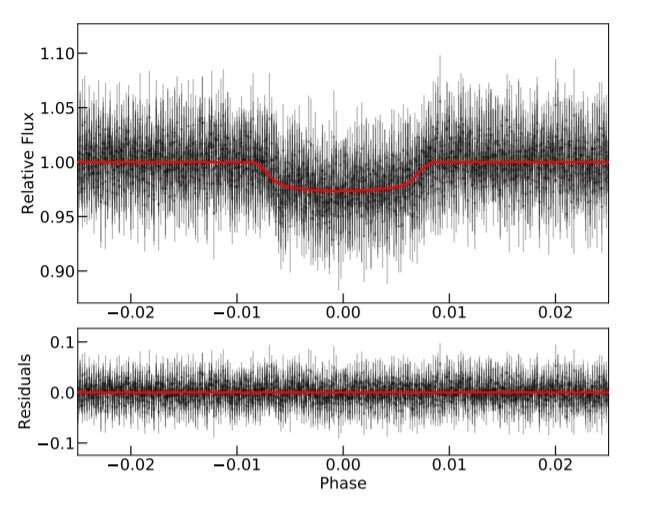Top panel: Phase-folded TESS photometry of TOI-530. The red solid line represents the median posterior model. Bottom panel: The residuals of the TESS data after subtracting the best-fit transit model. Credit: Gan et al., 2021.
Using NASA's Transiting Exoplanet Survey Satellite (TESS), an international team of astronomers has detected a new giant alien world. The newfound exoplanet, designated TOI-530b, is only about 17 percent smaller than Jupiter. The finding is reported in a paper published October 8 on the arXiv pre-print repository.
TESS is conducting a survey of about 200,000 of the brightest stars near the sun with the aim of searching for transiting exoplanets. So far, it has identified over 4,500 candidate exoplanets (TESS Objects of Interest, or TOI), of which 159 have been confirmed so far.
A group of astronomers led by Tianjun Gan of Tsinghua University in Beijing, China, has recently confirmed another TOI monitored by TESS. They report that a transit signal has been identified in the light curve of an M dwarf star known as TOI-530. The planetary nature of this signal was confirmed by follow-up observations.
"We report the discovery of TOI-530b, a transiting giant planet around an M0.5V dwarf, delivered by the Transiting Exoplanet Survey Satellite. ... We verify the planetary nature of the transit signals by combining ground-based multi-wavelength photometry, high resolution spectroscopy from SPIRou [SpectroPolarimètre InfraROUge] as well as high-angular-resolution imaging," the researchers wrote in the paper.
TOI-530b has a radius of about 0.83 Jupiter radii, while its mass is estimated to be 0.4 Jupiter masses. This gives a density at a level of 0.93 g/cm3. The planet orbits its parent star every 6.39 days at a distance of 0.052 AU from it. The equilibrium temperature of TOI-530b was calculated to be some 565 K. The planetary system is located about 481.5 light years away from the Earth.
The host TOI-530 (also known as TIC-387690507) is an M dwarf about half the size and mass of the sun. The star has a metallicity of approximately 0.376 and its effective temperature is estimated to be 3,659 K. The absolute V-band magnitude of TOI-530 was found to be 15.4 mag, while its bolometric luminosity was measured to be 0.049 solar luminosities. This makes it one of the faintest stars accessible by ground-based spectroscopy.
In concluding remarks, the authors of the paper noted that although TOI-530b is not a promising target for future atmospheric composition studies due to the faintness of the host star, it could be used by astronomers for some other purposes.
"TOI-530b is the sixth transiting giant planet hosted by an M-type star,which is predicted to be infrequent according to core accretion theory, making it a valuable object to further study the formation and migration history of similar planets," the scientists explained.
Gan's team proposes future observations of the TOI-530 system to further investigate its properties. The researchers suggest that the system should be investigated with high precision radial velocity spectrographs on large telescopes like the red-optical MAROON-X or near-infrared instruments like InfraRed Doppler spectrograph (IRD).
More information: Tianjun Gan et al, TOI-530b: A giant planet transiting an M dwarf detected by TESS. arXiv:2110.04220v1 [astro-ph.EP], arxiv.org/abs/2110.04220
© 2021 Science X Network
























